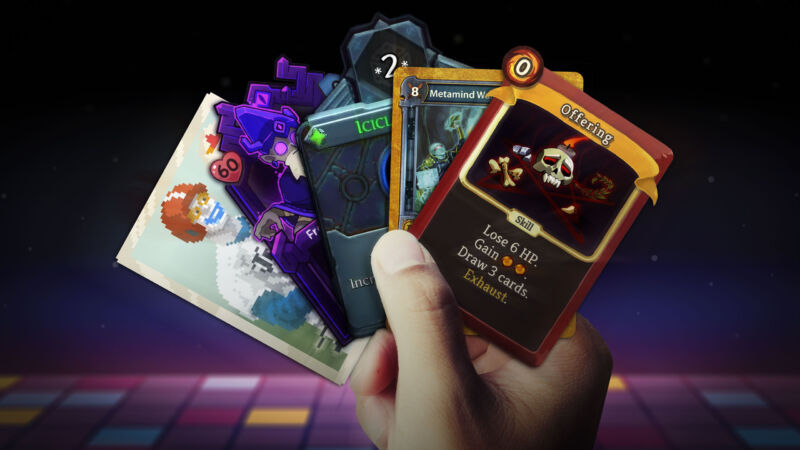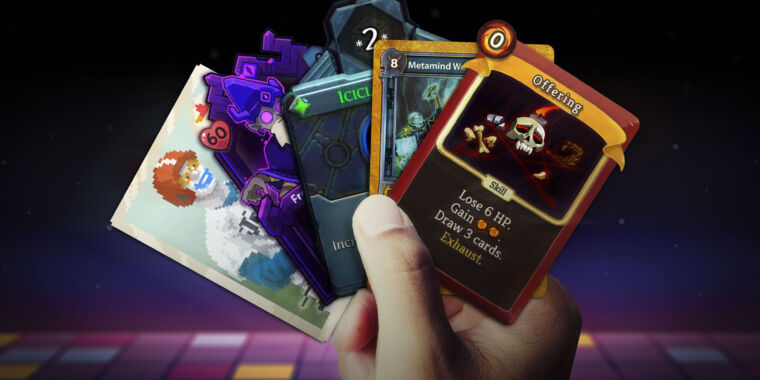Why there are 861 roguelike deckbuilders on Steam all of a sudden
A very full house —
9 answers from 8 devs about why combat card games on screens have blown up.

Aurich Lawson
In a deckbuilding game, you start out with a basic set of cards, then upgrade it over time, seeking synergies and compounding effects. Roguelikes are games where death happens quite often, but each randomized “run” unlocks options for the future. In both genres, and when they’re fused together, the key is staying lean, trimming your deck and refining your strategy so that every card and upgrade works toward unstoppable momentum.
“Lean” does not describe the current scene for roguelike deckbuilder games, but they certainly have momentum. As of this writing, Steam has 2,599 titles tagged by users with “deckbuilding” and 861 with “roguelike deckbuilder” in all languages, more than enough to feed a recent Deckbuilders Fest. The glut has left some friends and co-workers grousing that every indie game these days seems to be either a cozy farming sim or a roguelike deckbuilder.
I, an absolute sucker for deckbuilders for nearly five years, wanted to know why this was happening.
-
In Slay the Spire, and most roguelike deckbuilders, you battle enemies by drawing cards and playing a limited number of them: attack, defend, buff, debuff, etc. Crucially, enemies show you what they are going to do next, so you can triage and strategize.
MegaCrit
-
Winning battles nets you random new card choices, which may or may not fit your strategy.
MegaCrit
-
You choose which path to take, full of battles, stores, random “encounters,” rest stops, and “Elite” battles that are more rewarding.
MegaCrit
-
Stores and encounters will often let you buy cards or artifacts, and sometimes remove them, too.
MegaCrit
-
Roguelike deckbuilder bosses are often designed to challenge build strategies and force adaptability.
MegaCrit
-
Or, as often happens, you just die and start over with more cards and upgrades unlocked for next time.
MegaCrit
What is so appealing to developers and players about single-player card games made for screens? How do developers differentiate their deckbuilders? And how do you promote a title in a niche but crowded field?
Seeking these answers, I spoke with a bunch of roguelike deckbuilder developers, and I read interviews and watched conference talks from others. Some common themes and trends revealed themselves. Like a well-honed deck, each element fed into and bolstered the others.
But let’s first go back to the beginning, to perhaps the most powerful single element of roguelike deckbuilders’ success: two college friends in their 20s, tired of working QA jobs.
Slay the Spire’s starting point
Slay the Spire marked what was arguably the start of modern, single-player roguelike deckbuilder video games. Some games may technically have combined combat-oriented deckbuilding with the procedural generation and die/improve/repeat nature of roguelikes, but the 2019 game was the first to crack the formula and build a big audience around it. Slay the Spire also broadly boosted enthusiasm for single-player card games on computers in general—games other than Windows’ Solitaire, at least.
Video directed by Justin Wolfson, edited by John Cappello. Click here for transcript.
In a video interview with Ars Technica, and at Game Developer Conference (GDC) talks in 2019 on marketing and balancing, developers Anthony Giovannetti and Casey Yano told the game’s story. Giovannetti and Yano had met in college and made some one-off games, then graduated and got jobs. Giovannetti was a card game and tabletop enthusiast, even briefly managing a game store. He was certainly familiar with deckbuilding pioneer Dominion, but his main game was Netrunner—he still maintains the community site StimHack. Yano worked at Amazon, where he said he picked up the company’s “customer obsession” mentality.
In mid-2015, the two reconnected and went all-in on making their genre-melding concept, initially named “Card Crawl.” Starting with stick-figure drawings, a procedurally generated progression scheme cribbed from FTL, and input from some advanced Netrunner playtesters, they worked until the game was ready for early access on Steam. Chief among their in-development discovery was broadcasting enemy intents to the player and simplifying visuals and indicators until they were readable at a glance, even in a foreign language.
Slay the Spire launched in Steam’s Early Access after more than two years of development in November 2017. It sold 200 copies on day one, 300 on day two, and 150 on day three, declining from then on. The developers had made trailers, sent more than 600 emails to press and other outlets, and in the critical first two weeks of release, they had only sold 2,000 copies.
Things looked grim, but eventually, some of the 200 keys they sent to streamers led to some live play. An influential Chinese streamer’s Slay session garnered more than 1 million views, which nudged the game up the top seller list, leading to further sales, which sparked more streams, and so on. Grateful for their second wind, the team released new patches every week and used statistical feedback from early sessions to further tune the game. They took care not to remove “overpowered” strategy discoveries because they understood the joy of “a well-powered Rube Goldberg machine.”
Despite critical raves, a 99 percent positive Steam review rating, and more than 1.5 million sales by September 2019, Yano told the GDC crowd that “we never really improved how to, like, sell the game. I would say it’s still really word-of-mouth. But it’s been doing well that way, so I think we’re gonna keep going that way.”
Multiple developers I spoke with cited Slay the Spire as inspiration; one had more than 1,000 hours in it. The game’s design and success have compounded a few times over, creating new starting points. Balatro‘s developer claimed to have not played deckbuilders before making his own, but he was fascinated by streams of Luck Be a Landlord. That slot machine roguelike was, per its developer’s blog, heavily influenced by Slay the Spire. Even if you don’t know it, you probably know it.
Why there are 861 roguelike deckbuilders on Steam all of a sudden Read More »
